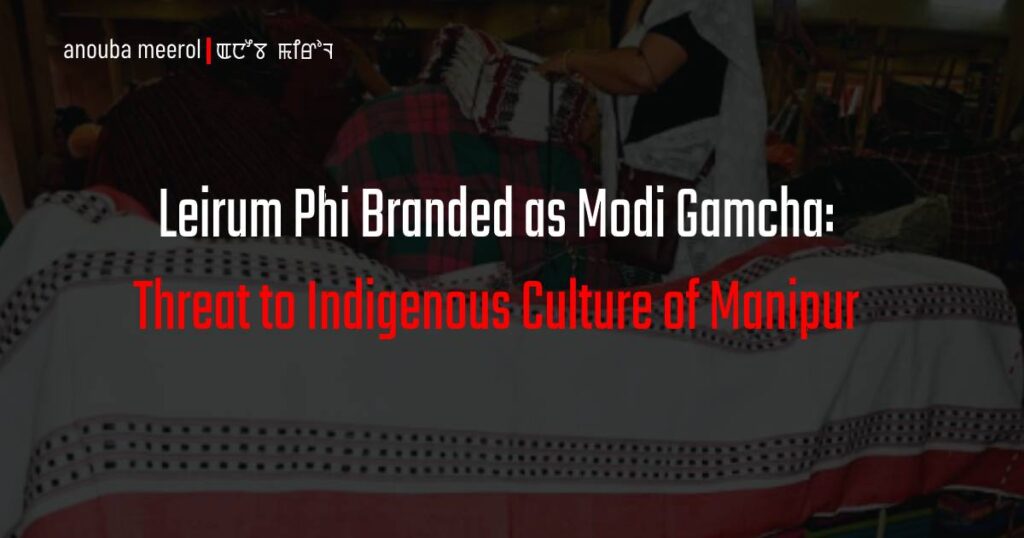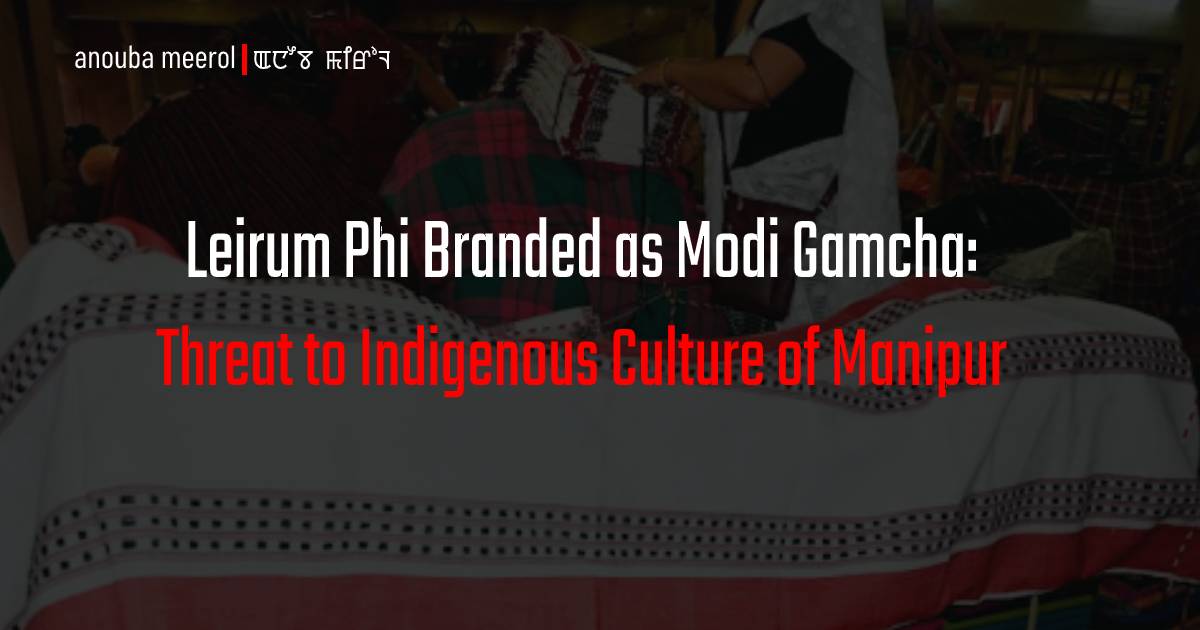
~ Cecil Thounaojam
Leirum Phi has an important historical, social and cultural value for the people of Manipur. It is not just a piece of cloth to wrap around the neck and use as a mask. Rather, it holds a strong association with indigenous culture and a symbol of relationship between indigenous communities. Leirum Phi not only showcases cultural creativity but it also embodies the labour of indigenous people. Now, newspaper reports tell us that this garment is branded as ‘PM Modi’s Gamcha’ and manufactured in Uttar Pradesh. Many have taken to social media shouting cultural appropriation after learning that the garment is now manufactured in Uttar Pradesh. Some are claiming that the mass production of this garment in Uttar Pradesh is an attempt to make money out of indigenous culture of Manipur and a disrespect to the indigenous people of Manipur.
Oral Traditions, Ruirum Kachon and Leirum Phi
Ruirum Kachon is a shawl traditionally worn by the eldest male member of the clan and lineage in Tangkhul society. Tangkhul village chiefs also wear Ruirum Kachon. This garment, either in the form of a shawl or a scarf, signifies a particular social status among Tangkhuls. This cultural object is not only exclusive to Tangkhuls, they share this cultural object with the Meiteis. Oral traditions of the Meitei community reveal that this cultural object carries along with it narratives on the relationship between Tangkhuls and Meiteis. Ruirum Kachon is known to the Meities as Leirum Phi. In one oral narrative, Pakhangba, the first king of Meiteis, introduced Leirum Phi among the Meiteis after he received it from the Tangkhuls when he made peace with them. Leirum Phi, therefore, symbolises ‘living together.’ Pakhangba declared that all Meiteis both rich and poor will use this garment in marriages.
According to another narrative, Nongpok Ningthou, a Tangkhul chief worshiped as a Meitei deity, fell in love with Panthoibi, a female Meitei deity and they decided to elope. The legend has it that when Nongpok Ningthou came to elope with Panthoibi, she wrapped her belongings in the Leirum Phi that he brought with him. Leirum Phi also symbolises the relationship between the clan of Angom and Tangkhuls of Hungpung, according to a different narrative. Angom chief gifted Leirum Phi to his daughter at her marriage. After that, gifting of Leirum Phi to the daughters by the parents in marriage became a tradition. It is not only a cultural object but also is one of the many indigenous weaving crafts, a source of livelihood. Traditionally, among the Meiteis only Salchiram saagei (lineage) weaves the Leirum Phi. Now, it is the indigenous women of Manipur who are weaving and selling Leirum Phi or Ruirum Kachon.
Modi Gamcha Branding and Cultural Appropriation
Prime Minister Narendra Modi appeared on national media wearing Leirum Phi as a Lengyan (scarf) on many occasions recently. After that, Leirum Phi has become very popular in mainland India. Now, the popularity of Leirum Phi is being capitalised on by the people in mainland India. Newspaper reports tell us that now Leirum Phi is mass-produced in Barabanki in Uttar Pradesh and now branded as ‘PM Modi’s Gamcha.’ Economic times’ story on ‘Modi Gamcha’ tells us that the garment has become a “game changer” for the weavers of Barabanki. It also reports that the garment is very popular and they are now selling it like hotcakes. Since the Prime Minister has been seen wearing the garment during his announcements on COVID-19 in national media, it is also advertised as a product which can be used as a mask. These developments have forced the Director of Manipur’s Handloom and Textiles department to write a letter to the Ministry of Textiles at the Centre urging the central government to intervene and stop the production in the interest of weavers of Manipur. This indicates the seriousness of the matter.
It is clear from this that the dominant mayang community is using the popularity of this garment as a business opportunity and the garment is being mass-produced now for the consumption of mainland Indian people just like any other piece of cloth. This cultural appropriation and capitalisation not only erases the uniqueness of Leirum Phi and the indigenous culture of Manipur, but also disrespects the labour and cultural creativity of indigenous people. Here, one needs to understand that cultural appropriation is not just about someone adopting a culture outside their community. It comes with a power dynamic where the dominant community takes cultural elements of a systematically oppressed community and capitalises on it. Therefore, cultural appropriation reduces the Leirum Phi or Ruirum Kachon to just a piece of cloth that the dominant mayang community can capitalise on with mass production.
It is a part of our indigenous identity and is worn by many to reclaim our indigeneity, our indigenous culture which is facing the threat of extinction. With this mass production, misidentification, and branding of it as ‘Modi Gamcha,’ it would not be long for Leirum Phi to be lost amongst different types of clothes manufactured in India for profit. It poses a great threat to our indigenous identity, which indigenous people are now struggling hard to revive and protect. If it is not taken care of now, our Leirum Phi or Ruirum Kachon will soon turn into a ‘Modi Gamcha.’

If we want to live with dignity as we are children of our dignified ancestors we should protect our ancestral identities even at the cost of our lives.
Shut up,,,if this hadn’t happened to the leirum or as I call it leitrum phi then would you have even talked about it, and do your commentary
Do you know that the suffix “Singh””in your name was accorded to by the Mayangs which you detest openly